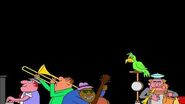
The credits sequences sorted in order of debut (from top to bottom): Wizard, Music, Painting, Programmer, Phone, Voiceover and Cheering.
Every game includes a credits sequence accessible from the options menu. In most cases, these credits sequences not only list off the people who worked on the game, but also include an animation to accompany it. These animations all have the same style and many appear across multiple games in the series, and they are related to the current list of people displayed. They also all use a jazz score for the background music composed by Joey Edelman, and this in turn was usually included in its entirety as a bonus CD audio track. Four games in the series have a unique set of credits (more on that below). The credits sequences are listed in order of which they first debuted.
Wizard
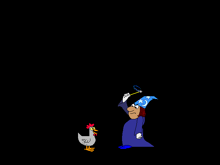
Wizard
A wizard attempts to create a dog out of nothing, but at first struggles making anything at all, then makes a rat but is dissatisfied, then morphs it to a chicken. Still frustrated, he tries one more time, and is successful at making a dog. However, as he is giving an aside for his accomplishment, the dog morphs into a large dragon unbeknownst to him. The dragon pulls the wizard's sleeve to get his attention, which completely scares the wizard and leads to him fainting. The dragon simply gives an aside glance, chuckling.
This credit sequence has no real consistency on who it includes; depending on which game it appears in, it may include either the production staff, artistic direction, programming team, music, sound engineers, and/or voice actors. Because of this, it is considered to be a "wild credits sequence".
Appearances:
- Just Grandma and Me
- The Tortoise and the Hare
- Arthur's Birthday
- Sheila Rae, the Brave
- The Berenstain Bears in the Dark
- Green Eggs and Ham (audio only, no SFX)
Music

Music
A pianist, a trombone player, and a double bass player all prepare to play the jazz score that accompanies the credits, with a one-man-band on the far right occasionally interrupting with cartoonish noises. The one-man-band is equipped with a whole slew of instruments, such as a saxophone, a bass drum, a bike horn, a cow bell, and even a green bird. After multiple interruptions occur, he finishes off by shooting a pop-gun. This is followed by glass breaking in the distance, shocking the other musicians.
This sequence is almost always accompanied by the sound team, including music, sound engineers, and voice actors. It has by far the most appearances across the Living Books games.
Appearances:
- Just Grandma and Me (with different tune in V1)
- The New Kid on the Block
- Little Monster at School (minus the CD-i version)*
- Arthur's Birthday
- Harry and the Haunted House
- The Berenstain Bears Get in a Fight
- Dr. Seuss' ABC
- Sheila Rae, the Brave
- The Berenstain Bears in the Dark
- Green Eggs and Ham (audio only, no SFX)
- Stellaluna
- Arthur's Reading Race
- The Cat in the Hat
NOTE: Games that this animation was not originally included on are marked with an asterisk (*).
Painting

Painting
A male and female artist are painting a red triangle and a green circle, respectively. The male painter mistakenly flings some of his to the female painter, which the female painter strikes back in retaliation by intentionally flinging her red paint back onto his green paint. This fight goes on for some time, until it eventually ends with them splashing their paint buckets on each other's canvases. However, their red triangle and green circle both shows up again afterwards, with each taking notice. They are both pleased by this, and shake hands.
This is almost always used when the artistic team is being listed off.
Appearances:
- Arthur's Teacher Trouble
- Little Monster at School
- Harry and the Haunted House
- The Berenstain Bears Get in a Fight
- Dr. Seuss' ABC
- Sheila Rae, the Brave
- Arthur's Birthday (some international versions)*
- The Berenstain Bears in the Dark
- Green Eggs and Ham (audio only)
- Arthur's Reading Race
- The Cat in the Hat
NOTE: Games that this animation wasn’t originally included on are marked with an asterisk (*).
Programmer
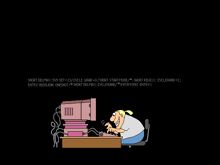
Programmer
A programmer sits in front of his computer, starting to type away. A bunch of nonsense code starts to appear above, but he takes it too far away and the cords turn burning red, causing the computer to overheat, overload, and eventually explode and fall apart (in a cartoonish fashion). In the aftermath, a cube lands on the programmer's head, then he is exasperated as the computer's screen starts blinking red within its electrical buzzing noises. (In Arthur's Teacher Trouble, there is a slightly longer ending where the programmer glances at the player and chuckles "b-huh" in a sad tone.)
This scene is typically accompanied with the programming team.
Appearances:
- Arthur's Teacher Trouble (the only time "b-huh" is heard)
- The New Kid on the Block ⚑
- Little Monster at School (minus the CD-i version)*
- Arthur's Birthday
- Harry and the Haunted House ⚑
- Dr. Seuss' ABC ⚑
- Stellaluna
- Arthur's Reading Race
- Just Grandma and Me (V2 only)*
- The Cat in the Hat
NOTE: Games that this animation wasn’t originally included on are marked with an asterisk (*). Games in which this animation lacks the ceiling crash sound effect are marked with a flag (⚑). The ceiling crash sound effect from The New Kid on the Block, Harry and the Haunted House, and Dr. Seuss' ABC aren’t used after the programmer’s computer explodes.
Phone

Phone
A worker is taking in calls from two phones at the same time, all while a group of people open the door to his left and start tossing him all sorts of shapes, all while he begins to juggle them. After the group of people leave, the worker tosses his shapes up into the air, and starts catching all of the falling shapes and stacking them up onto his finger. After that, the worker gives an aside glance and waves his arm out, with one phone hanging on his arm and ringing.
This is an obvious visual representation of what working on the production staff can feel like, showing how many things they can have to worry about at once. Likewise, the production staff is usually featured whenever this one comes up.
Appearances:
Voiceover

Voiceover
A director with recording equipment for a voiceover session holds a microphone up to a lady, who then screams very loud and blows the director's headphones away, making the volume meter on the recording machine break the volume scale with bursting sound waves. The headphones fling back onto the director's head in boomerang motion, who then then decides to do a sound test on a kitty cat who is sleeping. The lady then steps on the cat's tail, making the cat screech and run off the screen, hence the volume meter on the recording machine reaching the perfect volume that doesn't break the volume limit. The director then makes an "okay" sign with his finger to show approval to the lady. He then gives an aside glance and raises his eyebrows.
Like the Music credits animation, this one was only involved with the sound team, including music, sound engineers, and voice actors.
Appearances:
- Little Monster at School (Philips CD-i version only)
NOTE: This credits animation is extremely scarce to come across as it only appears in the credits on the Phillips CD-i version of Little Monster at School, and never made it into any of the Windows/Macintosh computer versions of any Living Books game. It was exclusively made in 320x200 resolution unlike other credits sequences, and this one has been long forgotten until it was recovered by a YouTuber, GeorgeQGreg, and subsequently uploaded by ARemoteAndRandomName (video provided below).
Cheering
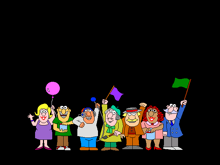
Cheering
Seven people stand in a line facing the screen, all cheering. At the end of the animation, within a few seconds, the blonde woman on the far left accidentally lets go of a balloon and it pops, startling everyone.
This is used to show the remaining members not already covered in other sections, like quality assurance and special thanks. This animation is always positioned after the Music animation when it doesn't have enough vacancy to make room for said crediting lists.
Appearances:
Unique Credits Sequences
Four games in the series do not follow the traditional credits, instead adopting a custom one.
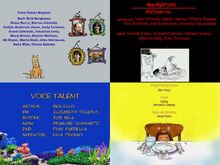
Unique Credits Sequences. From top to bottom, Ruff's Bone, Green Eggs and Ham, Arthur's Computer Adventure, and D.W. the Picky Eater.
- Ruff's Bone: On the left the credits roll, and Ruff sits underneath them, while on the right there are four picture portraits with a member of the development team appearing on each picture. The game's usual title theme substitutes Joey Edelman's jazz score.
- Green Eggs and Ham: While Joey Edelman's score is used for this sequence, the animations are substituted for a storyboard sequence of every page, but does borrow the audio soundtrack for the wizard, artists and music.
- Arthur's Computer Adventure: The credits are placed in front of a Deep Dark Sea background with a unique score that is actually used from the Deep Dark Sea mini game.
- D.W. the Picky Eater: The credits scroll in front of the page from the book where D.W. is peeking over the dinner table, with various music from the game playing.
Original Variant of the Credits Theme

Living Books Credits Music (Rare 1992 Variants) original
The original variants of the credits music.
This variant was only used in Just Grandma and Me and Arthur's Teacher Trouble. The Wizard's background music had the main piano track at a lower volume and different quality to the piano instruments, the Music animation performs the same tune as the Programmer one but with the trombone, the music in the Painting animation remained identical but only with different quality to the instruments (except the clarinet remained the same), and the Programmer animation featured the entire uncut song without getting the ending piece cut off in the middle (despite the first half of the first piece being cut like how the Music animation always plays out).
Trivia
- It is implied that all the credits animations were made during production on Just Grandma and Me so that the producers of the Living Books games could take the animations and make up a random sequence of credits animations for each game.
- The Wizard, Phone and Cheering animations rank the least number of appearances in the series, with the Voiceover one being the scarcest for only appearing on the Philips CD-i version of Little Monster at School.
- The only two games to exclude the Music animation were Arthur's Teacher Trouble and The Tortoise and the Hare, unless you count the Philips CD-i version of Little Monster at School.
- Along with this, the Painting and Programmer animations are the second ones to have the most appearances in the games, behind the Music animation.
- Not counting Arthur's Birthday V2, The Cat in the Hat is the last Living Books game to use the traditional jazz credits animations, including the Phone, Painting, Programmer, Music, and Cheering animations.
- Not counting Arthur's Birthday V2, the Wizard animation on the other hand last appears in The Berenstain Bears in the Dark.
- Both of Mercer Mayer's titles were the only Living Books games to have changed their credits sequences in later releases (V2 for the former and the PC/Mac versions for the latter), unless you count some international versions of Arthur's Birthday, Harry and the Haunted House, and Sheila Rae, the Brave.
- When the dragon scared the wizard, the wizard's skin was changing from dark to white. The wizard's scream was silent as the music was playing in the way, although his mouth opens as if he had actually screamed.
- In the Cheering animation, the people's cheering was silent as the music was playing in the way, although they move as if they are actually cheering.
- In the first two games Just Grandma and Me (V1) and Arthur's Teacher Trouble, the Wizard, Music, Painting and Programmer animations had several sound differences (including louder cymbal instruments), along with minor graphic differences, compared to the usual versions seen in later games.
- In the credits for Just Grandma and Me, the Wizard animation's music was composed at a different session, where the main piano track was lower in volume amplification, faded into the background and barely able to be heard, making the background instruments much louder than the main piano track. This was corrected in the credits for the The Tortoise and the Hare onward (and even for the UK release of Just Grandma and Me). There is also a goof where the mouse disappears in one frame when the wizard turns him into a chicken. There is also a longer ending where the dragon opens his eyelids a bit more after three seconds of silence.
- The original version of the wizard animation is still on Just Grandma and Me V2 and the Hebrew dub of the game.
- The longer ending of silence was also used in The Tortoise and the Hare, minus the bit of the dragon opening his eyelids a bit more.
- In the original version of the Music animation as seen in Just Grandma and Me V1, the trombonist wears a lighter-green shirt and the cellist wears light-purple pants. There is a slightly longer beginning showing the pianist lifting his arms to prepare for playing the piano (like how the Programmer does before typing). The piano intro also had different quality to the music, the cellist's "All right!" line was a separate audio sample not mixed with the piano intro (hence cutting off the piano music when he says his line), and the trombonist was playing a tune that had the same arrangement as the Programmer animation. In all the other games (even in Just Grandma and Me V2), this type of trombone tune (being like the tune from the Programmer) was no longer used– the trombonist instead plays the main tune of the Living Books Credits song that was used in the Phone animation.
- In Arthur's Teacher Trouble, the music in the Painting animation was rendered at a different session, where the background instruments (behind the clarinet) had different quality to the music. The animation was also slightly sped up (like in a similar way to where your PC takes a bit to buffer up and the animation tries to catch up to sync in with the sound).
- The original version of the Programmer animation had the beginning portion of the music (and animation) cut, and the Programmer tune also had the full 3rd piece (which was cut on the CD audio track and in later games) that can be heard if you find a way to pause the animation to let the entire sound play (more on that below). At the end after the computer stops making electric zapping sounds, the programmer looks at the viewer with a sad look on his face and says "b-huh" in a sad tone. He doesn't say this in any other games he appeared in.
- In the credits for Just Grandma and Me, the Wizard animation's music was composed at a different session, where the main piano track was lower in volume amplification, faded into the background and barely able to be heard, making the background instruments much louder than the main piano track. This was corrected in the credits for the The Tortoise and the Hare onward (and even for the UK release of Just Grandma and Me). There is also a goof where the mouse disappears in one frame when the wizard turns him into a chicken. There is also a longer ending where the dragon opens his eyelids a bit more after three seconds of silence.
- In the original version of the Phone animation, there is a longer ending where the worker's phone hanging on his arm is still ringing. This was done to make way for the music to finish playing through the animation.
- For an unknown reason, as early versions of the Living Books Credits animations from the first two games were phased out by the time both The Tortoise and the Hare and The New Kid on the Block were released, a clarinet version of the Programmer tune was never composed. It is unknown if it was never composed in the first place, or if Joey Edelman did compose it but never physically used it in a credits sequence.
- Despite this, the Voiceover animation oddly doesn't have a tune of its own composed– it just uses a combination of instrumentals from other credits sequences: It uses the one from Wizard, then Programmer, thirdly Phone, and finally a merge of the clarinet/piano/trombone.
- A reconstruction of the aforementioned clarinet version of the Programmer tune was composed by a YouTuber for the Voiceover animation, with an attempt of using an electronic keyboard to get the clarinet instrument to sound identical, along with using some instrumental tracks from the CD audio track (for the background music) and the original versions of the Wizard and Programmer animations (for the rhythmic cymbals).
- In The New Kid on the Block, the Programmer and Music animations also have a variation as follows:
- The Programmer animation's intro was cut and treated just like in Arthur's Teacher Trouble, except with only the entire 1st piece of the song playing without the 2nd or 3rd pieces. When the computer made electrical buzzing noises at the end, one frame of the Programmer's mouth showing his teeth was erroneously stretched extremely out of scale.
- The Music animation uses the main tune of the Living Books credits from the Phone animation for the first time, but the 3rd piece was oddly used in place of the 1st piece, making the 3rd piece accidentally used twice.
- Little Monster at School's later credits sequence including Painting, Programmer, and Music has been reused in Harry and the Haunted House and Dr. Seuss' ABC, with minor graphic and audio changes.
- The Dr. Seuss' ABC version of the Programmer animation also cuts the portion where the guy continues to type on his keyboard and bends down as he continues typing, making it jump from his glance towards the viewer straight to the computer about to blow up.
- The ceiling crash sound effect can be only heard from Arthur's Teacher Trouble, Little Monster at School, Arthur's Birthday, Stellaluna, Arthur's Reading Race, The Cat in the Hat, and Just Grandma and Me V2.
- In the The New Kid on the Block, Harry and the Haunted House and Dr. Seuss' ABC variants of the Programmer animation, the ceiling crash sound effect doesn't play after the programmer's computer explodes.
- In Arthur's Teacher Trouble, the ceiling crash sound effect is intact, but cut off by the "boing" sound effect due to the computer exploding sound effect (with which the ceiling crash sound effect was actually part of) having ran for longer than the animation (this was before the other games fixed it by letting the animation pause and wait for the animation to finish). However, there's two ways to hear the crash sound effect in this game:
- If you play the game on ScummVM, you can hear the sound effects still playing past the animation pause point, hence merging in other sound effects at the same time instead of cutting them off.
- If you play it on an older pre-OS 9 Mac computer, you would have to click and hold the window bar at the top screen to pause the animation and wait for the sound effect to finish.
- In Arthur's Teacher Trouble, the ceiling crash sound effect is intact, but cut off by the "boing" sound effect due to the computer exploding sound effect (with which the ceiling crash sound effect was actually part of) having ran for longer than the animation (this was before the other games fixed it by letting the animation pause and wait for the animation to finish). However, there's two ways to hear the crash sound effect in this game:
- In the credits for Little Monster at School (PC/Mac versions), the ending of the Painting animation is shortened down, making the two artists shake hands only twice.
- The following goofs appear in the credits for Arthur's Birthday:
- When the wizard first throws his wand to the surface, there is a small dot on his uniform beneath his face, then the dot disappears after he frowns before trying to hit the wand some more.
- When the wizard spins his wand around after creating a chicken, he raises his eyebrows twice.
- In the UK, German and French versions of some games, his eyebrows stay up after he raises them once. However, in the German and French dubs of Just Grandma and Me, his arm spinning the wand clicks twice and he raises his eyebrows very slowly.
- After the one-man-band pulls the parrot's tail and when the parrot glares at him, the parrot's sad eye expressions blink back and forth while it steps away from the one-man-band.
- In the credits for Little Monster at School (PC/Mac versions) and Arthur's Birthday, at one point in the Programmer animation when the guy keeps typing on his computer, the following graphic/color errors occurred:
- The computer's wires turned dark blue instead of red.
- In some shots, blue-green spots flash on the the guy's white shirt sleeves. After the computer explodes, the guy's entire white shirt turns blue-green which persists through the remainder of the animation (fixed in V2 of Arthur's Birthday).
- The computer's wires and monitor were also blue green (the ceiling-crash sound effect from the credits in later games was used for the first time without being cut off).
- When the computer's monitor was blinking in front of the guy's face after he lies down on his desk, the shining from the computer's blinking red monitor in front of the guy's face was blue instead of red.
- In some international versions of Little Monster at School, Arthur's Birthday, Harry and the Haunted House, and Sheila Rae, the Brave, the credits sequences were cut down/changed to show only the Painting and Music animations. For some reason, The Berenstain Bears Get in a Fight reversed the order of the Painting and Music animations for its credits, making the Painting animation list the voice actors, quality assurance, and special thanks– which that animation doesn't associate with.
- In The Berenstain Bears Get in a Fight version of the Music animation, the silent portion of the beginning with no audio was cut (jumping immediately to the pianist already playing the piano), the animation of the musicians performing the tune was slightly different, the trombonist was stepping back very slowly when the one band man was about to pull out the pop-up gun, the musicians do not jump out in shock until after a few seconds of the glass breaking, and the parrot remains shocked throughout the entire end.
- The parrot also kept this expression throughout the entire end of the credits in the Tandy VIS version of Just Grandma and Me as well.
Videos
Credits sequences used
| Sequences | Used in |
|---|---|
| Wizard, Music | Just Grandma and Me (V1 only) |
| Painting, Programmer | Arthur's Teacher Trouble |
| Phone, Wizard | The Tortoise and the Hare |
| Programmer, Music | The New Kid on the Block |
| Painting, Voiceover | Little Monster at School (Philips CD-i port only) |
| Painting, Programmer, Music |
Little Monster at School |
| Wizard, Programmer, Music |
Arthur's Birthday |
| Music, Painting | The Berenstain Bears Get in a Fight |
| Painting, Music | Only used in UK/German/French versions of: Arthur's Birthday Harry and the Haunted House Sheila Rae, the Brave |
| Wizard, Painting, Music |
Sheila Rae, the Brave |
| Painting, Wizard, Music |
Sheila Rae, the Brave (Italian dub only; the order of Wizard and Painting was accidentally reversed on this release) |
| Phone, Programmer, Music, Cheering | Stellaluna |
| Painting, Programmer, Music, Cheering | Arthur's Reading Race |
| Phone, Painting, Programmer, Music, Cheering | The Cat in the Hat |
